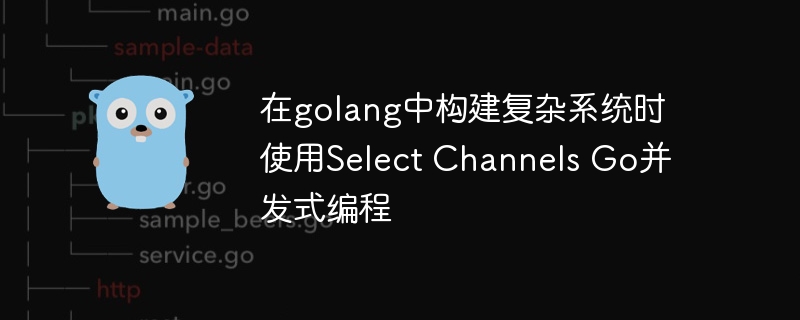

Concurrent programming using Select and Channels is a very common and powerful tool when building complex systems in Golang. By leveraging these features, efficient, reliable, and flexible concurrent operations can be achieved. This article will introduce how to use Select and Channels to build complex systems in Golang, and provide some specific code examples.
First of all, we need to understand the key concepts in concurrent programming: goroutine and channel. Goroutine is a concurrent execution unit in Golang, which is equivalent to a lightweight thread. Using goroutine, multiple functions or methods can be executed simultaneously, thereby improving the concurrency performance of the program. Channel is a communication mechanism between goroutines, used to transfer data between different goroutines.
In Golang, there are three ways to communicate using channels: unbuffered channel, buffered channel and select statement.
Unbuffered channel is an unbuffered channel that needs to wait for the other party's operation when sending and receiving data. If the send operation is performed first, the sending goroutine will be blocked until another goroutine performs the receive operation. Conversely, if the receive operation is performed first, the receiving goroutine will also be blocked until another goroutine performs the send operation. This method is usually used for direct data transfer between two goroutines.
Buffered channel is a channel with a buffer that does not need to wait for the other party's operation immediately when sending and receiving data. When the send operation is executed, if the buffer is not full, the data is written to the buffer and returns immediately; if the buffer is full, the sending goroutine will be blocked. Similarly, when the receive operation is executed, if the buffer is not empty, the data is read from the buffer and returned immediately; if the buffer is empty, the receiving goroutine will be blocked. This method is usually used for buffered data transfer between multiple goroutines.
The select statement is a mechanism for selecting between multiple channels. It is similar to a switch statement and can execute corresponding code blocks based on the results of multiple communication operations. Through the select statement, non-blocking channel operations can be implemented to avoid goroutine blocking.
The following is a sample code using select and channels, showing how to build complex systems in Golang:
package main
import (
"fmt"
"time"
)
func worker(id int, jobs <-chan int, results chan<- int) {
for j := range jobs {
fmt.Println("Worker", id, "started job", j)
time.Sleep(time.Second)
results <- j * 2
fmt.Println("Worker", id, "finished job", j)
}
}
func main() {
jobs := make(chan int, 5)
results := make(chan int, 5)
for w := 1; w <= 3; w++ {
go worker(w, jobs, results)
}
for j := 1; j <= 5; j++ {
jobs <- j
}
close(jobs)
for a := 1; a <= 5; a++ {
<-results
}
}In the above sample code, we define a worker function, which Receive tasks from the jobs channel, perform the task's work, and send the results to the results channel. Then, we created 3 goroutines in the main function to execute the worker function. Each worker function obtains the tasks in the jobs channel and sends the results to the results channel. Finally, we read the results from the results channel and print them.
In the main function, we use a for loop to send 5 tasks to the jobs channel, and close the jobs channel after completing the sending. We then read 5 results from the results channel using a for loop and discarded those results.
Through the above code examples, we can see how simple and powerful concurrent programming using select and channels is. We can easily build efficient, reliable and flexible concurrent systems. Of course, this is just a simple example, and more complex logic and operations may be required in actual applications. But in any case, the concurrent programming model using select and channels will be an important tool for implementing complex systems.
To sum up, concurrent programming using select and channels is very powerful and commonly used in Golang. Through it, we can easily achieve efficient, reliable and flexible concurrent operations. At the same time, we can also flexibly choose unbuffered channel, buffered channel or select statements according to specific needs and scenarios to meet different requirements. I hope this article can provide some help for everyone's understanding and application of concurrent programming in Golang.
The above is the detailed content of Using Select Channels Go concurrent programming when building complex systems in golang. For more information, please follow other related articles on the PHP Chinese website!
 How to define variables in golang
How to define variables in golang
 What are the data conversion methods in golang?
What are the data conversion methods in golang?
 What are the commonly used libraries in golang?
What are the commonly used libraries in golang?
 What is the difference between golang and python
What is the difference between golang and python
 Server monitoring software
Server monitoring software
 What are the big data storage solutions?
What are the big data storage solutions?
 The installer cannot create a new system partition solution
The installer cannot create a new system partition solution
 Router default password
Router default password




